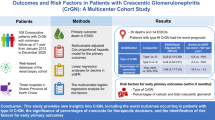Abstract
Background
The clinicopathological characteristics and outcome with pauci-immune crescentic glomerulonephritis (CreGN) are presumed to vary over time. We examined the characteristics and outcome of Japanese patients with CreGN according to the treatment periods.
Patients and methods
From 1968 to 2011, we examined a total of 102 patients diagnosed with pauci-immune CreGN by renal biopsy. The patients were divided into three groups according to the treatment periods—Group I (1968–1988, n = 18), Group II (1989–2001, n = 37; when the nationwide survey of rapidly progressive glomerulonephritis [RPGN] was performed in Japan), and Group III (2002–2011, n = 47; after publication of the Japanese guideline for RPGN).
Results
There were no significant differences in blood pressure, renal function or anti-neutrophil cytoplasmic antibody titer between groups. On the other hand, the rate of crescent formation and degree of interstitial inflammatory cell infiltration were decreased in Group III. Serum creatinine (<3.0, 3.0–6.0, ≥6.0 mg/dL) and crescent formation (<30, 30–50, 50–80, ≥80 %) were significant renal prognostic factors in Group III [serum creatinine: hazard ratio (HR) 4.79, 95 % confidence interval (CI) 1.43–16.1, P = 0.011; crescent formation: HR 2.86, 95 % CI 1.06–7.73, P = 0.039]. Furthermore, renal survival rate of patients with crescent formation <50 % and patient survival rate of patients with serum creatinine <3 mg/dL were improved in Group III.
Conclusion
Patients with CreGN were diagnosed in the early phase of crescent formation and outcome has improved in recent years.





Similar content being viewed by others
References
Churg J, Bernstein J, Glassock RJ, editors. Classification of glomerular disease. Renal disease: classification and atlas of glomerular diseases. 2nd ed. New York: Igaku-shoin Medical; 1995. p. 11.
Koyama A, Yamagata K, Makino H, Arimura Y, Wada T, Nitta K, et al. A nationwide survey of rapidly progressive glomerulonephritis in Japan: etiology, prognosis and treatment diversity. Clin Exp Nephrol. 2009;13:633–50.
Bajema IM, Hagen EC, Hermans J, Noël LH, Waldherr R, Ferrario F, et al. Kidney biopsy as a predictor for renal outcome in ANCA-associated necrotizing glomerulonephritis. Kidney Int. 1999;56:1751–8.
Hauer HA, Bajema IM, Van Houwelingen HC, Ferrario F, Noël LH, Waldherr R, et al. Determinants of outcome in ANCA-associated glomerulonephritis: a prospective clinico-histopathological analysis of 96 patients. Kidney Int. 2002;62:1732–42.
de Lind van Wijngaarden RA, Hauer HA, Wolterbeek R, Jayne, Gaskin G, Rasmussen N, et al. Clinical and histologic determinants of renal outcome in ANCA-associated vasculitis: a prospective analysis of 100 patients with severe renal involvement. J Am Soc Nephrol. 2006;17:2264–74.
Berden AE, Ferrario F, Hagen EC, Jayne DR, Jennette JC, Joh K, et al. Histopathologic classification of ANCA-associated glomerulonephritis. J Am Soc Nephrol. 2010;21:1628–36.
Neumann I, Kain R, Regele H, Soleiman A, Kandutsch S, Meisl FT. Histological and clinical predictors of early and late renal outcome in ANCA-associated vasculitis. Nephrol Dial Transplant. 2005;20:96–104.
Takeda S, Kida H, Yokoyama H, Tomosugi N, Kobayashi K. Two distinct types of crescentic glomerulonephritis. Clin Nephrol. 1992;37:285–93.
Takeda S, Kida H, Yokoyama H, Takazakura E, Kobayashi K. Methylprednisolone pulse therapy in two clinical types of crescentic glomerulonephritis. Intern Med. 1998;37:585–91.
Ito-Ihara T, Ono T, Nogaki F, Suyama K, Tanaka M, Yonemoto S, et al. Clinical efficacy of intravenous immunoglobulin for patients with MPO-ANCA-associated rapidly progressive glomerulonephritis. Nephron Clin Pract. 2006;102:c35–42.
Martinez V, Cohen P, Pagnoux C, Vinzio S, Mahr A, Mouthon L, et al. Intravenous immunoglobulins for relapses of systemic vasculitides associated with antineutrophil cytoplasmic autoantibodies: results of a multicenter, prospective, open-label study of twenty-two patients. Arthritis Rheum. 2008;58:308–17.
Jayne DR, Gaskin G, Rasmussen N, Abramowicz D, Ferrario F, Guillevin L, et al. Randomized trial of plasma exchange or high-dosage methylprednisolone as adjunctive therapy for severe renal vasculitis. J Am Soc Nephrol. 2007;18:2180–8.
Szpirt WM, Heaf JG, Petersen J. Plasma exchange for induction and cyclosporine A for maintenance of remission in Wegener’s granulomatosis—a clinical randomized controlled trial. Nephrol Dial Transplant. 2011;26:206–13.
Hasegawa M, Ohashi A, Kabutan N, Hiramatsu S, Kato M, Murakami K, et al. Cytapheresis for the treatment of myeloperoxidase antineutrophil cytoplasmic autoantibody-associated vasculitis: a pilot study of 21 patients. Ther Apher Dial. 2006;10:412–8.
Jayne D, Rasmussen N, Andrassy K, Bacon P, Tervaert JW, Dadoniené J, et al. A randomized trial of maintenance therapy for vasculitis associated with antineutrophil cytoplasmic autoantibodies. N Engl J Med. 2003;349:36–44.
Pagnoux C, Mahr A, Hamidou MA, Boffa JJ, Ruivard M, Ducroix JP, et al. Azathioprine or methotrexate maintenance for ANCA-associated vasculitis. N Engl J Med. 2008;359:2790–803.
Hirayama K, Kobayashi M, Hashimoto Y, Usui J, Shimizu Y, Hirayama A, et al. Treatment with the purine synthesis inhibitor mizoribine for ANCA-associated renal vasculitis. Am J Kidney Dis. 2004;44:57–63.
Jones RB, Ferraro AJ, Chaudhry AN, Brogan P, Salama AD, Smith KG, et al. A multicenter survey of rituximab therapy for refractory antineutrophil cytoplasmic antibody-associated vasculitis. Arthritis Rheum. 2009;60:2156–68.
Wada T, Hara A, Arimura Y, Sada KE, Makino H, Research Group of Intractable Vasculitis Ministry of Health, Labor and Welfare of Japan. Risk factors associated with relapse in Japanese patients with microscopic polyangiitis. J Rheumatol. 2012;39:545–51.
Acknowledgments
We thank the physicians and staff members at the collaborative institutions for participating in this study and for providing data. This work was financially supported in part by Grants-in-Aid for Progressive Renal Diseases Research, Research on Intractable Disease, and for Intractable Vasculitis from the Ministry of Health, Labour and Welfare of the Japanese Government.
Conflict of interest
The authors declare that no conflicts of interest exist.
Author information
Authors and Affiliations
Consortia
Corresponding author
About this article
Cite this article
Kitagawa, K., Furuichi, K., Shinozaki, Y. et al. Long-term observations of clinicopathological characteristics and outcome of Japanese patients with pauci-immune crescentic glomerulonephritis. Clin Exp Nephrol 17, 858–865 (2013). https://doi.org/10.1007/s10157-013-0798-4
Received:
Accepted:
Published:
Issue Date:
DOI: https://doi.org/10.1007/s10157-013-0798-4




